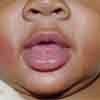Photoclinic: Aplasia Cutis Congenita With the "Hair Collar Sign"
The parents of this 4-month-old infant were concerned about an atrophic, 0.6-cm area on their son's parietal scalp that was surrounded by dark hair. The rest of the scalp was normal, and the child was otherwise healthy. Benjamin Barankin, MD, of Edmonton, Alberta, made the clinical diagnosis of the hair collar sign--growth of long, dark, coarse hair around a scalp lesion that may be a marker for underlying defects. The sign is sometimes found in association with aplasia cutis congenita, in which a portion of skin is absent--most commonly this manifests as a solitary round lesion on the scalp. These lesions may have healed at birth with a scar or they may remain eroded or ulcerated.

The parents of this 4-month-old infant were concerned about an atrophic, 0.6-cm area on their son's parietal scalp that was surrounded by dark hair. The rest of the scalp was normal, and the child was otherwise healthy. Benjamin Barankin, MD, of Edmonton, Alberta, made the clinical diagnosis of the hair collar sign--growth of long, dark, coarse hair around a scalp lesion that may be a marker for underlying defects. The sign is sometimes found in association with aplasia cutis congenita, in which a portion of skin is absent--most commonly this manifests as a solitary round lesion on the scalp. These lesions may have healed at birth with a scar or they may remain eroded or ulcerated.
The membranous variant of aplasia cutis congenita is most likely associated with a hair collar sign and underlying abnormalities. In this particular variant, the skin covering the lesion has a thin, parchment-like appearance. In the newborn period, the lesion appears as a translucent, soft cyst that with time transforms into a flat, atrophic scar. The depth of involvement can vary and may include all levels of tissue. Although usually benign, the hair collar sign may be associated with other physical anomalies and malformation syndromes.
No specific laboratory tests are required, although a hair collar sign signals the possibility of a CNS malformation and thus may warrant an MRI scan to rule out an underlying pathology. Results of an MRI scan in this patient were normal. The defect was thought to be a benign, isolated finding.
Minor scarred lesions, such as the one in this infant, require no treatment. For eroded or ulcerated lesions, treatment depends on the lesion size. Options include topical antibiotic therapy or surgical repair and grafting. The prognosis is excellent for most patients.
References:
FOR MORE INFORMATION:
Commens C, Rogers M, Kan A. Heterotropic brain tissue presenting as bald cysts with a collar of hypertrophic hair. The "hair collar" sign.
Arch Dermatol.
1989;125:1253-1256.
Drolet BA, Clowry L Jr, McTigue MK, Esterly NB. The hair collar sign: marker for cranial dysraphism.
Pediatrics.
1995;96:309-313.
Drolet B, Prendiville J, Golden J, et al. "Membranous aplasia cutis" with hair collars. Congenital absence of skin or neuroectodermal defect?
Arch Dermatol.
1995;131:1427-1431.
Recognize & Refer: Hemangiomas in pediatrics
July 17th 2019Contemporary Pediatrics sits down exclusively with Sheila Fallon Friedlander, MD, a professor dermatology and pediatrics, to discuss the one key condition for which she believes community pediatricians should be especially aware-hemangiomas.